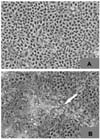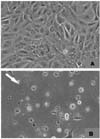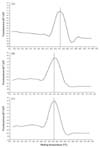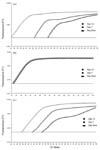1. Aspehaug VT. Characterization of major structural proteins of the infectious salmon anemia virus (ISAV). 2005. Norway: University of Bergen;Doctoral Thesis.
2. Bouchard D, Keleher W, Opitz HM, Blake S, Edwards KC, Nicholson BL. Isolation of infectious salmon anemia virus (ISAV) from Atlantic salmon in New Brunswick, Canada. Dis Aquat Organ. 1999. 35:131–137.

3. Clouthier SC, Rector T, Brown NE, Anderson ED. Genomic organization of infectious salmon anaemia virus. J Gen Virol. 2002. 83:421–428.

4. Dannevig BH, Falk K, Press CM. Propagation of infectious salmon anemia (ISA) virus in cell culture. Vet Res. 1995. 26:438–442.
5. Deregt D, Loewen KG. Bovine viral diarrhea virus: biotypes and disease. Can Vet J. 1995. 36:371–378.
6. Devold M, Falk K, Dale B, Krossoy B, Biering E, Aspehaug V, Nilsen F, Nylund A. Strain variation, based on the hemagglutinin gene, in Norwegian ISA virus isolates collected from 1987 to 2001: indications of recombination. Dis Aquat Organ. 2001. 47:119–128.

7. Devold M, Krossoy B, Aspehaug V, Nylund A. Use of RT-PCR for diagnosis of infectious salmon anaemia virus (ISAV) in carrier sea trout Salmo trutta after experimental infection. Dis Aquat Organ. 2000. 40:9–18.

8. Falk K, Dannevig BH. Demonstration of infectious salmon anaemia (ISA) viral antigens in cell cultures and tissue sections. Vet Res. 1995. 26:499–504.
9. Falk K, Namork E, Dannevig BH. Characterization and applications of a monoclonal antibody against infectious salmon anaemia virus. Dis Aquat Organ. 1998. 34:77–85.

10. Falk K, Namork E, Rimstad E, Mjaaland S, Dannevig BH. Characterization of infectious salmon anemia virus, an orthomyxo-like virus isolated from Atlantic salmon (
Salmo salar L.). J Virol. 1997. 71:9016–9023.

11. Grant R, Smail DA. Comparative isolation of infectious salmon anaemia virus (ISAV) from Scotland on TO, SHK-1 and CHSE-214 cells. Bull Eur Assoc Fish Pathol. 2003. 23:80–85.
12. Gregory A. Detection of infectious salmon anemia virus (ISAV) by in situ hybridization. Dis Aquat Organ. 2002. 50:105–110.

13. Hellebo A, Vilas U, Falk K, Vlasak R. Infectious salmon anemia virus specifically binds and hydrolyzes 4-O-acetylated sialic acids. J Virol. 2004. 78:3055–3062.

14. Hodneland K, Endresen C. Sensitive and specific detection of Salmonid alphavirus using real-time PCR (TaqMan). J Virol Methods. 2006. 131:184–192.

15. Joseph T, Kibenge MT, Kibenge FS. Antibody-mediated growth of infectious salmon anaemia virus in macrophage-like fish cell lines. J Gen Virol. 2003. 84:1701–1710.

16. Kibenge FSB. Molecular studies on infectious salmon anaemia virus. Bull Aquacul Assoc Canada. 2004. 104:71–78.
17. Kibenge FSB, Garate ON, Johnson G, Arriagada R, Kibenge MJT, Wadowska D. Isolation and identification of infectious salmon anaemia virus (ISAV) from Coho salmon in Chile. Dis Aquat Organ. 2001. 45:9–18.

18. Kibenge FSB, Kibenge MJT, McKenna PK, Stothard P, Marshall R, Cusack RR, MaGeachy S. Antigenic variation among isolates of infectious salmon anaemia virus correlates with genetic variation of the viral haemagglutinin gene. J Gen Virol. 2001. 82:2869–2879.

19. Kibenge FSB, Lyaku JR, Rainnie D, Hammell KL. Growth of infectious salmon anaemia virus in CHSE-214 cells and evidence for phenotypic differences between virus strains. J Gen Virol. 2000. 81:143–150.

20. Kibenge MJT, Munir K, Kibenge FSB. Constitutive expression of Atlantic salmon Mx1 protein in CHSE-214 cells confers resistance to infectious salmon anaemia virus. Virol J. 2005. 2:75.

21. Kibenge FSB, Munir K, Kibenge MJT, Joseph T, Moneke E. Infectious salmon anemia virus: causative agent, pathogenesis and immunity. Anim Health Res Rev. 2004. 5:65–78.

22. Kristiansen M, Froystad MK, Rishovd AL, Gjoen T. Characterization of the receptor-destroying enzyme activity from infectious salmon anemia virus. J Gen Virol. 2002. 83:2693–2697.

23. Krossoy B, Devold M, Sanders L, Knappskog PM, Aspehaug V, Falk K, Nylund A, Koumans S, Endresen C, Biering E. Cloning and identification of the infectious salmon anemia virus hemagglutinin. J Gen Virol. 2001. 82:1757–1765.
24. Lovdal T, Enger O. Detection of infectious salmon anemia virus in seawater by nested RT-PCR. Dis Aquat Organ. 2002. 49:123–128.
25. Mackay IM, Arden KE, Nitsche A. Real-time PCR in virology. Nucleic Acids Res. 2002. 30:1292–1305.

26. Mikalsen AB, Teig A, Helleman AL, Mjaaland S, Rimstad E. Detection of infectious salmon anaemia virus (ISAV) by RT-PCR after cohabitant exposure in Atlantic salmon Salmo salar. Dis Aquat Organ. 2001. 47:175–181.

27. Mjaaland S, Markussen T, Sindre H, Kjoglum S, Dannevig BH, Larsen S, Grimholt U. Susceptibility and immune responses following experimental infection of MHC compatible Atlantic salmon (
Salmo salar L.) with different infectious salmon anaemia virus isolates. Arch Virol. 2005. 150:2195–2216.

28. Mjaaland S, Rimstad E, Falk K, Dannevig BH. Genomic characterization of the virus causing infectious salmon anemia in Atlantic salmon (
Salmo salar L.): an orthomyxo-like virus in a teleost. J Virol. 1997. 71:7681–7686.

29. Moneke EE, Kibenge MJ, Groman D, Johnson GR, Ikede BO, Kibenge FSB. Infectious salmon anemia virus RNA in fish cell cultures and in tissue sections of Atlantic salmon experimentally infected with infectious salmon anemia virus. J Vet Diagn Invest. 2003. 15:407–417.

30. Munir K, Kibenge FSB. Detection of infectious salmon anaemia virus by real-time RT-PCR. J Virol Methods. 2004. 117:37–47.

31. Niesters HGM. Quantitation of viral load using real-time amplification techniques. Methods. 2001. 25:419–429.

32. Niesters HGM. Clinical virology in real-time. J Clin Virol. 2002. 25:S3–S12.
33. Nylund A, Devold M, Plarre H, Isdal E, Aarseth M. Emergence and maintenance of infectious salmon anaemia virus (ISAV) in Europe: a new hypothesis. Dis Aquat Organ. 2003. 56:11–24.

34. Nylund A, Kvenseth AM, Krossoy B. Susceptibility of wild salmon (Salmo salar L.) to infectious salmon anemia (ISA). Bull Eur Assoc Fish Pathol. 1995. 15:152–156.
35. Nylund A, Kvenseth AM, Krossoy B, Hodneland K. Replication of the infectious salmon anaemia virus (ISAV) in rainbow trout,
Oncorhynchus mykiss (Walbaum). J Fish Dis. 1997. 20:275–279.

36. Optiz HM, Bouchard D, Anderson E, Blake S, Nicholson B, Keleher W. A comparison of methods for the detection of experimentally induced subclinical infectious salmon anemia in Atlantic salmon. Bull Eur Assoc Fish Pathol. 2000. 20:12–22.
37. Plarre H, Devold M, Snow M, Nylund A. Prevalence of infectious salmon anaemia virus (ISAV) in wild salmonids in western Norway. Dis Aquat Organ. 2005. 66:71–79.

38. Raynard RS, Murray AG, Gregory A. Infectious salmon anaemia virus in wild fish from Scotland. Dis Aquat Organ. 2001. 46:93–100.

39. Reed LJ, Muench H. A simple method of estimating fifty percent endpoints. Am J Hyg. 1938. 27:493–497.
40. Ridpath JF. BVDV genotypes and biotypes: practical implications for diagnosis and control. Biologicals. 2003. 31:127–131.

41. Rimstad E, Falk K, Mikalsen AB, Teig A. Time course tissue distribution of infectious salmon anaemia virus in experimentally infected Atlantic salmon Salmo salar. Dis Aquat Organ. 1999. 36:107–112.

42. Rimstad E, Mjaaland S. Infectious salmon anemia virus: an orthomyxovirus causing an emerging infection in Atlantic salmon. APMIS. 2002. 110:273–282.

43. Rodger HD, Turnbull T, Muir F, Millar S, Richards RH. Infectious salmon anaemia (ISA) in the United Kingdom. Bull Eur Assoc Fish Pathol. 1998. 18:115–116.
44. Rolland JB, Bouchard D, Coll J, Winton JR. Combined use of the ASK and SHK-1 cell lines to enhance the detection of infectious salmon anemia virus. J Vet Diagn Invest. 2005. 17:151–157.

45. Rolland JB, Winton JR. Relative resistance of Pacific salmon to infectious salmon anaemia virus. J Fish Dis. 2003. 26:511–520.

46. Snow M, Raynard RS, Bruno DW. Comparative susceptibility of Arctic char (
Salvelinus alpinus), rainbow trout (
Oncorhynchus mykiss) and brown trout (
Salmo trutta) to the Scottish isolate of infectious salmon anaemia virus. Aquaculture. 2001. 196:47–54.

47. Wergeland HI, Jakobsen RA. A salmonid cell line (TO) for production of infectious salmon anaemia virus (ISAV). Dis Aquat Organ. 2001. 44:183–190.

48. Wittwer CT, Herrmann MG, Gundry CN, Elenitoba-Johnson KSJ. Real-time multiplex PCR assays. Methods. 2001. 25:430–442.










